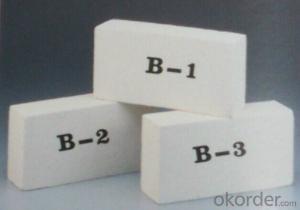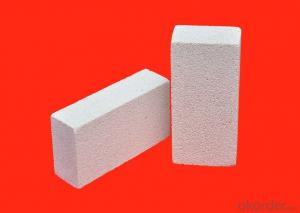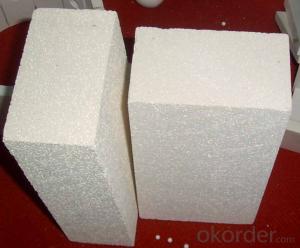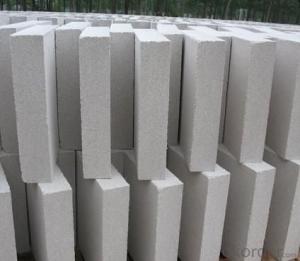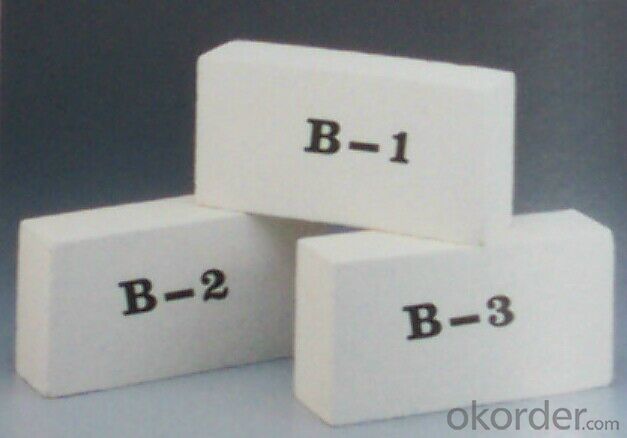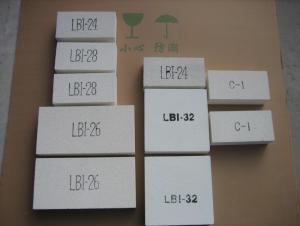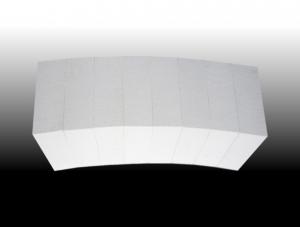Insulating Fire Brick - Refractory Mullite Insulating Refractory Brick JM 23
- Loading Port:
- Shanghai
- Payment Terms:
- TT OR LC
- Min Order Qty:
- 20 m.t.
- Supply Capability:
- 20 m.t./month
OKorder Service Pledge
OKorder Financial Service
You Might Also Like
Okorder series heat insulation brick
Okorder series thermal insulation brick is an effective, energy saving, low carbon, environmental protection advanced, according to the ASTM standard manufacturing products. Okorder series products have all kinds of materials in the field of metallurgy, industrial furnaces, aluminum, the best Li Ning petrochemical and insulation, electric power and glass ceramics. They can be used as part of an insulation or not to melt. Products have been widely used in the following furnace, achieved satisfactory results.
Application of heat preservation brick
Metallurgical Industry: blast furnace, hot blast furnace, heating furnace, etc..
Petrochemical Industry: ethylene cracking furnace, hydrogen furnace, the main furnace, heating furnace, etc..
Ceramic industry: roller kiln, kiln, etc..
Glass industry: glass furnace regenerator, etc.
Carbon industry: carbon furnace, etc..
Aluminum electrolysis industry: aluminum reduction cell, etc.
Other industries: tunnel kiln, shuttle kiln, etc..
Advantages of heat insulation brick
Low thermal conductivity: many air holes will bring good thermal insulation effect, energy saving.
High crushing strength: high crushing strength, volume stability.
Low heat storage: small heat storage, absorb more heat, energy-saving effect is obvious.
Chundu: High-speed Rail, low content of alkali metal impurities.
Accuracy: the size of the brick machining precision, cutting and grinding the special shape, speed up the brick.
Technical Data
ITEM | GJM30 | GJM28 | GJM26 | GJM23 |
Classification Temperature, ℉/℃ | 3000/1650 | 2800/1540 | 2600/1430 | 2300/1260 |
Bulk Density,g/cm³ | ≤1.0 | ≤0.9 | ≤0.8 | ≥0.5 |
Reheating Linear Change, % | ≤0.9 (1550℃,12 h) | ≤0.8 (1510℃,12 h) | ≤0.7 (1410℃,12 h) | ≤0.5 (1230℃,12 h) |
Al2O3 Content, % | ≥75 | ≥65 | ≥55 | ≥45 |
Fe2O3 Content, % | ≤0.5 | ≤0.6 | ≤0.7 | ≤1.0 |
Thermal Conductivity: | ||||
800℃, w/m.k | ≤0.39 | ≤0.37 | ≤0.35 | ≤0.18 |
1000℃, w/m.k | ≤0.43 | ≤0.41 | ≤0.39 | ≤0.20 |
1200℃, w/m.k | ≤0.48 | ≤0.46 | ≤0.43 | --- |
Insulating brick
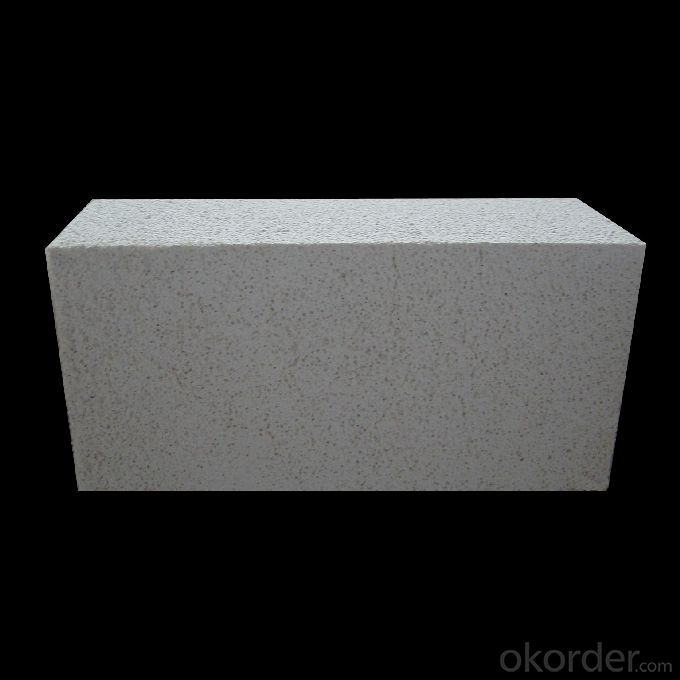
- Q: What are the new types of building brick materials?
- Sintered silt insulation brick, steam block, light building block, hollow clay brick, etc..
- Q: Can insulating fire bricks be used in the construction of heat recovery systems?
- Yes, insulating fire bricks can be used in the construction of heat recovery systems. Insulating fire bricks are designed to withstand high temperatures and provide excellent thermal insulation, making them an ideal choice for heat recovery systems. These bricks are made from lightweight materials, such as ceramic fibers or refractory materials, which have low thermal conductivity. This property allows them to effectively trap and retain heat, preventing it from escaping the system and maximizing energy efficiency. Additionally, insulating fire bricks are resistant to thermal shock, meaning they can withstand rapid temperature changes without cracking or breaking. This makes them suitable for the varying heat conditions often found in heat recovery systems. Overall, using insulating fire bricks in the construction of heat recovery systems can help improve their performance and efficiency by minimizing heat loss and optimizing energy recovery.
- Q: Can insulating fire bricks be used in the construction of autoclaves?
- Yes, insulating fire bricks can be used in the construction of autoclaves. Autoclaves require materials that can withstand high temperatures and pressures, and insulating fire bricks are designed to have excellent thermal resistance and insulation properties. These bricks are made from refractory materials like alumina, silica, and other additives that allow them to withstand extreme temperatures and thermal shocks. They are also lightweight and have low thermal conductivity, which helps to minimize heat loss and improve energy efficiency in autoclaves. Additionally, insulating fire bricks have good load-bearing capacity, making them suitable for the structural components of autoclaves. Overall, the use of insulating fire bricks in the construction of autoclaves helps to ensure the safety and efficiency of the equipment.
- Q: Do insulating fire bricks have good mechanical strength?
- Insulating fire bricks generally have moderate mechanical strength compared to regular fire bricks. While their main purpose is to provide excellent thermal insulation, they are still able to withstand some amount of mechanical stress. However, it is important to note that their mechanical strength may not be as high as other types of fire bricks, which are specifically designed to withstand heavier loads and abrasion. Therefore, if the application requires both high insulation and superior mechanical strength, it might be necessary to consider using a combination of insulating fire bricks and regular fire bricks to achieve the desired outcome.
- Q: Are insulating fire bricks resistant to salt attack?
- Insulating fire bricks are not typically resistant to salt attack. Salt attack refers to the corrosion and degradation of materials when exposed to salt or saltwater. While insulating fire bricks are designed to have excellent thermal insulation properties, they are not specifically formulated to withstand the corrosive effects of salt. Salt attack can lead to the breakdown of the bricks' structure, reducing their performance and durability over time. If these bricks are regularly exposed to salt or saltwater, it is likely that they will experience accelerated degradation and may not provide long-term reliability in such environments. To ensure resistance to salt attack, it is recommended to use refractory materials specifically designed for this purpose, such as salt-resistant fire bricks or refractories with higher alumina content. These materials have been developed to withstand the corrosive effects of salt and are more suitable for applications where exposure to salt or saltwater is expected.
- Q: Are insulating fire bricks resistant to moisture absorption?
- Yes, insulating fire bricks are resistant to moisture absorption. These bricks are specifically designed to have low porosity, which helps to prevent the absorption of moisture. The manufacturing process involves the use of high-quality refractory materials that are able to withstand high temperatures and resist the effects of moisture. This makes insulating fire bricks an ideal choice for applications where moisture resistance is required, such as in kilns, furnaces, and other high-temperature environments.
- Q: Are insulating fire bricks suitable for use in the construction of smelters?
- Yes, insulating fire bricks are suitable for use in the construction of smelters. Insulating fire bricks are designed to withstand high temperatures and provide excellent insulation properties, making them ideal for applications such as smelters. They have low thermal conductivity, meaning they can effectively retain heat and reduce energy loss during the smelting process. Additionally, insulating fire bricks are resistant to thermal shock, which is crucial in smelting operations where rapid temperature changes are common. Their high heat resistance and insulation capabilities make insulating fire bricks a reliable choice for constructing smelters.
- Q: What are the disadvantages of using insulating fire bricks?
- Potential users should be aware of several disadvantages when using insulating fire bricks. Firstly, compared to other types of bricks, insulating fire bricks have a relatively low compressive strength. This means they may not be suitable for applications that require high structural integrity or load-bearing capacity. Excessive pressure or heavy loads can cause the bricks to crack or break, compromising the overall stability of the structure. Secondly, insulating fire bricks are more prone to erosion and wear compared to other types of bricks. They have a lower resistance to abrasion and chemical attack, which means they may deteriorate more quickly when exposed to harsh environments or aggressive substances. This can result in the need for more frequent maintenance or replacement of the bricks, leading to increased costs and efforts. Another drawback of insulating fire bricks is their relatively high thermal conductivity. Although they are designed to provide insulation and reduce heat transfer, they still allow some heat to pass through. This can be problematic in applications where maximum thermal insulation is required, as it may lead to heat loss and decreased energy efficiency. Furthermore, insulating fire bricks are typically more expensive than regular bricks or other insulation materials. Their specialized composition and manufacturing process contribute to higher production costs, which are then passed on to the consumer. This can make them less cost-effective for certain applications, especially when cheaper alternatives with similar insulation properties are available. Lastly, insulating fire bricks are generally not suitable for use in direct contact with high-temperature flames or extreme thermal conditions. While they can withstand high temperatures, there is a limit to their heat resistance. Exceeding this limit can cause the bricks to crack or even disintegrate, rendering them ineffective as insulation and potentially compromising the safety of the surrounding environment. In conclusion, while insulating fire bricks offer advantages in terms of thermal insulation and lightweight properties, they also have several disadvantages that should be taken into consideration. These include low compressive strength, susceptibility to erosion and wear, relatively high thermal conductivity, higher cost compared to other materials, and limited tolerance to extreme thermal conditions.
- Q: Are insulating fire bricks resistant to weathering or aging?
- Yes, insulating fire bricks are generally resistant to weathering and aging. These bricks are designed to withstand high temperatures and harsh conditions, making them durable and long-lasting. They are often used in applications where exposure to extreme weather, such as rain, snow, and sunlight, is common. However, it is important to note that the specific composition and quality of the bricks can vary, so it is advisable to consult the manufacturer or supplier for detailed information regarding their weathering and aging resistance properties.
- Q: Can insulating fire bricks be used in glass melting furnaces?
- Yes, insulating fire bricks can be used in glass melting furnaces. Insulating fire bricks are made with materials that have high insulating properties, such as lightweight refractory fibers, and are designed to minimize heat loss. In glass melting furnaces, where high temperatures are required, insulating fire bricks can be used to line the walls and roof of the furnace to reduce heat transfer to the surroundings and improve energy efficiency. They can help maintain high temperatures inside the furnace, reduce fuel consumption, and enhance the overall performance of the glass melting process. However, it is important to note that insulating fire bricks may have a lower resistance to chemical attack and wear compared to other refractory materials, so they may need to be supplemented with other types of refractories in certain parts of the furnace where harsh conditions are present.
Send your message to us
Insulating Fire Brick - Refractory Mullite Insulating Refractory Brick JM 23
- Loading Port:
- Shanghai
- Payment Terms:
- TT OR LC
- Min Order Qty:
- 20 m.t.
- Supply Capability:
- 20 m.t./month
OKorder Service Pledge
OKorder Financial Service
Similar products
Hot products
Hot Searches
Related keywords
